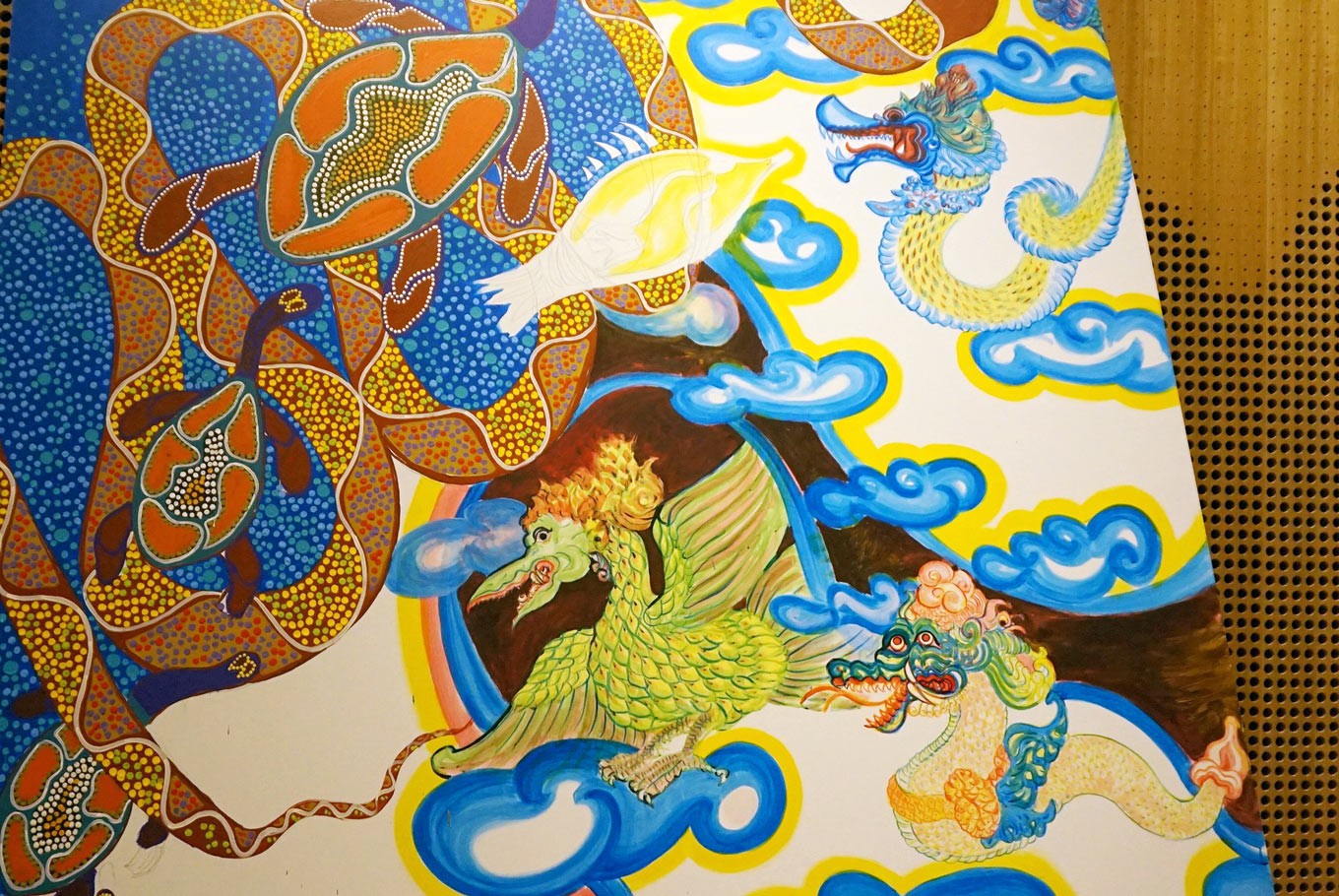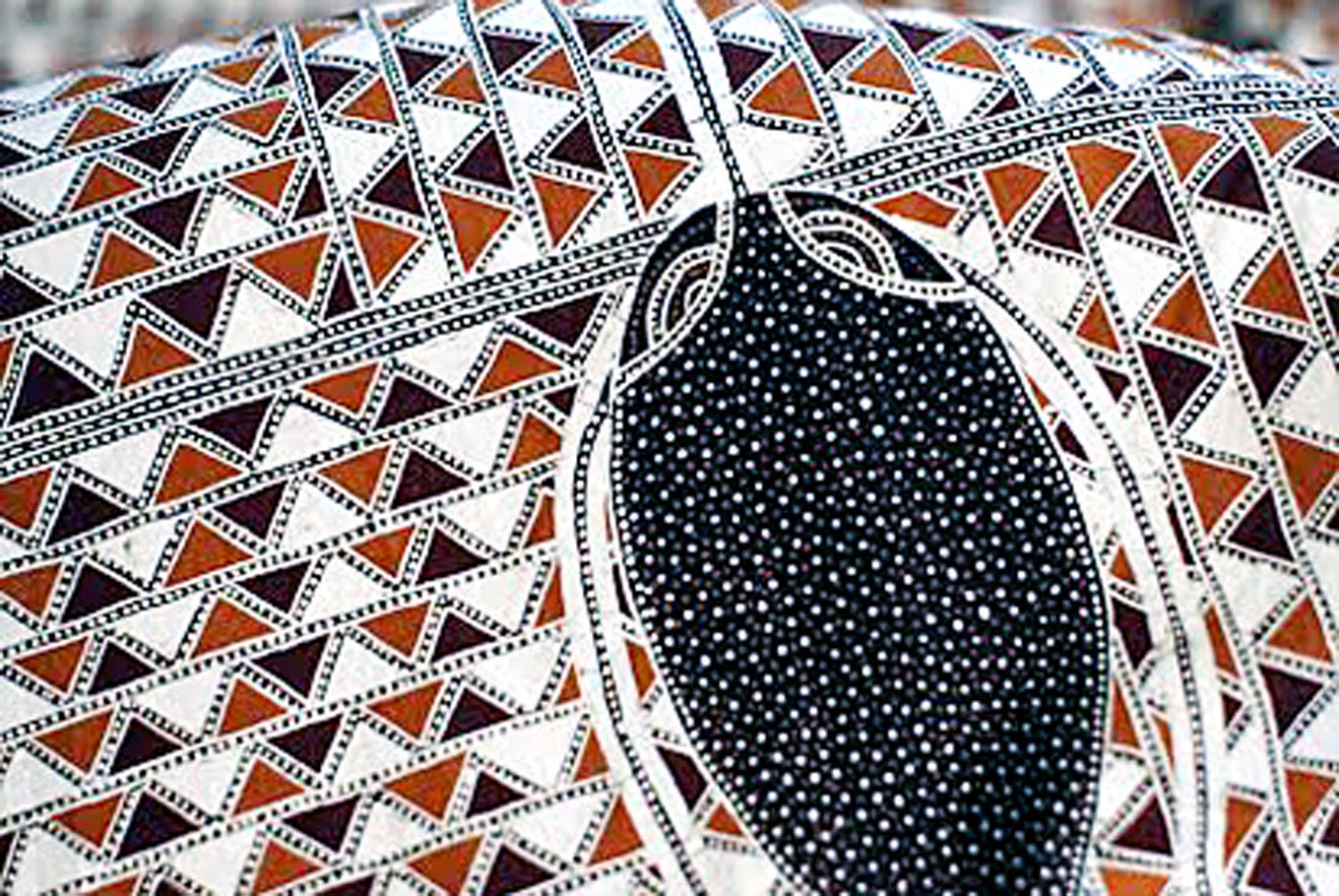Popular Reads
Top Results
Can't find what you're looking for?
View all search resultsPopular Reads
Top Results
Can't find what you're looking for?
View all search resultsAboriginal art in town
Collaborative canvas by Aboriginal Jandamarra Cadd and Indonesian artist Jerry Thung show the spirit of communication and collaboration in good humor.
Change text size
Gift Premium Articles
to Anyone
P
resident Joko “Jokowi” Widodo’s vlogging with Australia’s Prime Minister Malcolm Turnbull at the G20 Summit in Hamburg, Germany, and the collaborative canvas by Aboriginal Jandamarra Cadd and Indonesian artist Jerry Thung at the Australian Embassy in Jakarta show the same spirit of communication and collaboration in good humor.
The opening of an exhibition on indigenous art at the Australian Embassy on July 11 was marked by these features made visible on the canvas, which was placed as the center piece of the show. The show runs until Friday.
Cadd, known as a specialist of portraiture, and Jerry, a versatile artist who has delved in the philosophies of both the East and the West, decided to take land, water and sky as a joint theme for their collaborative canvas.
The serpent on Cadd’s side of the canvas denotes the myth of creation, the dots reflect the seas, while Jerry takes into the skies symbolized by clouds that are often seen in the Megamendung batiks of Cirebon, West Java.
The exhibition proper is in fact an allegory of art works made by aboriginal people, from the very simple drawings of fish to the abstract dots, the figurative and the realistic, including portraiture.
Read also: Australia-Indonesia cultural relationship: Those who shaped our critical mind
But the most interesting might be the dot paintings, made up of small dots of paint colors like yellow (representing the sun), brown (the soil), red (desert sand) and white (the clouds and the sky).
 Batik touch: A collaborative canvas by Aboriginal Jandamarra Cadd and Indonesian artist Jerry Thung is on display at an exhibition on Australian indigenous art at the Australian Embassy in Jakarta until Friday.(JP/Carla Bianpoen)
Batik touch: A collaborative canvas by Aboriginal Jandamarra Cadd and Indonesian artist Jerry Thung is on display at an exhibition on Australian indigenous art at the Australian Embassy in Jakarta until Friday.(JP/Carla Bianpoen)
For those unfamiliar with aboriginal dot painting, a first impression could be that of pointillism, the dotted art from early modernity that developed in the late 1880s and was first used to describe the work of French artist Georges Seurat. Or maybe the dots in Japanese artist Yayoi Kusama’s works come to mind.
But the dots in aboriginal art were first used hundreds of years ago as a form to disguise the sacred designs that belonged to a particular ceremony. Originally made on sand, the practice later (only in the 1970s) went over to canvas, which made the paintings more durable (and commercially viable). Sometimes, the dots are so tiny that they appear as a line. This is apparent in, among others, the painting Mulligan-Goorbadjim by Judy Mengil, which used natural earth pigments and synthetic polymer binder.
While originally, the colors used were yellow, brown, red and white, in a later development, other colors became prominent, as seen in the green colored painting Kata Ala by Maringka Baker.
Read also: Indonesian language literacy: What Australia can learn from South Korea
Of course Australia’s proximity to Indonesia is generally well-known, particularly Arnhem Land in Northern Australia, where the Bugis seafarers left their trace, among others in the name Marege for Arnhem, a Makassar word that is originally combined with le’leng, which means black.
This connection with Indonesia is also evident in the batik cloth that was based on a bark painting and created by an elder artist in residence under the North-East Arnhem Land’s Yirrkala Arts Center, who was inspired by his ancestral links to Makassar.
Also from Arnhem Land is the Lorrkon, or hollow log coffin, featuring a tree trunk hollowed out by termites and painted before the deceased’s bones were laid inside.
Ambassador Paul Grigson expressed his delight to present the Indigenous Artwork Collection of the Australian Embassy Jakarta for the first time in a single space.
The works are usually on display in three separate locations: The Chancery Building, the Executive Residence and the Ambassador’s Official Residence.
“It is a token of respect for indigenous Australian’s values and connection to the country,” Grigson said.











